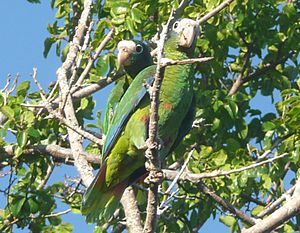Hispaniolan amazon facts for kids
Quick facts for kids Hispaniolan parrot |
|
|---|---|
 |
|
| Conservation status | |
| Scientific classification | |
| Genus: |
Amazona
|
| Species: |
ventralis
|
 |
|
The Hispaniolan parrot (Amazona ventralis), also called the Hispaniolan amazon, is a type of parrot. It lives only on the island of Hispaniola, which includes the Dominican Republic and Haiti. You can spot it by its white forehead, light-colored beak, and a blue patch near its ears. It also has a maroon patch on its belly. This parrot is about 28 centimeters (11 inches) long. An adult usually weighs around 250 grams (8.75 ounces).
This parrot used to be found all over Hispaniola. However, its numbers dropped a lot during the 1900s. By the 1930s, it mostly lived in the mountains. Today, you might even see them in big cities like Santo Domingo.
Contents
About the Hispaniolan Parrot
How We Know About Them
A German scientist named Philipp Ludwig Statius Müller first described this parrot in 1776. But even before that, in 1535, a Spanish historian named Gonzalo Fernández de Oviedo wrote about them. He called them "Higuacas," which was the name the native Taíno people used.
Oviedo described different types of parrots on the island. He noted that the "Higuacas" had white foreheads, unlike parrots on other islands. He said they were very good at learning human words. He also mentioned another type, called "xaxabis," which were noisier and more irritable. These "xaxabis" never learned to speak human words.
Scientists believe the Hispaniolan parrot, the Cuban amazon, and the Puerto Rican amazon all came from a Central American parrot called the White-fronted amazon. DNA studies suggest that Amazon parrots first arrived in Hispaniola about 760,000 years ago.
What the Hispaniolan Parrot Looks Like
Hispaniolan parrots have bright green feathers. Many of their feathers have blue edges. They have black feathers covering their ears. You can also see blue patches on their cheeks and the top of their heads. There are some red patches under their chin. A clear white area is on their forehead and around their eyes.
They also have red feathers on their bellies. The feathers under their wings are blue. Their tail is green with yellow tips. The outer tail feathers are red at the base. Their beak is a horn color, and they have brown eyes. Their feet are pale brown. As mentioned, they are about 28 centimeters long and have a strong, large beak.
Where the Hispaniolan Parrot Lives
These parrots live in many different types of forests. They can be found at about 1,500 meters (about 4,900 feet) above sea level. This includes dry palm groves, pine forests, and wet mountain forests. They often look for food in farms, like banana plantations and cornfields. You can find them at all heights in forests and thickets, as long as there are fruits and seeds for them to eat.
Today, most Hispaniolan parrots live in protected areas. These include national parks like Jaragua, Cotubanamá, and Los Haitises. They eat seeds and fruits from plants like Caesalpinia, Psidium, and Ficus.
How Many Hispaniolan Parrots There Are
It's estimated that there are about 10,000 to 19,999 Hispaniolan parrots in total. This means there are roughly 6,000 to 15,000 adult parrots.
Hispaniolan Parrot Reproduction
Hispaniolan parrots stay with the same partner for their whole lives. A female parrot usually lays 2 to 4 eggs at a time. They typically build their nests in holes in trees, often as high as 20 meters (about 65 feet) off the ground. However, some nests have been found as low as 1.5 meters (about 5 feet). They have also been seen nesting on rocky ledges.
The breeding season for these parrots is usually between February and June. Sometimes, pairs looking for nesting spots have been seen in mid-April, which suggests the season might last even longer.
Threats to the Hispaniolan Parrot
One big problem for these parrots is illegal trapping. People who illegally take chicks from nests can damage the tree cavities. Parrots use these same cavities year after year, so damaging them means fewer places for them to nest successfully.
Hispaniolan parrots are also hunted for food. They are trapped for local trade and for international trade as pet birds. Sometimes, farmers also see them as pests because they eat crops.
It is against the law in the Dominican Republic to trade or own these parrots.
See also
 In Spanish: Cotorra de La Española para niños
In Spanish: Cotorra de La Española para niños


